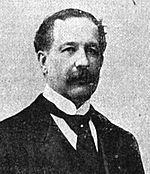Kilmainham Treaty facts for kids
The Kilmainham Treaty was an informal agreement made in May 1882. It was between William Ewart Gladstone, the British Prime Minister, and Charles Stewart Parnell, a leader for Irish rights.
Parnell was in jail at the time. He wanted to make a deal with the government. This deal was negotiated by Captain William O'Shea. The government agreed to help about 100,000 tenant farmers. They could ask for fair rent in special courts. In return, Parnell promised to help stop violence in Ireland. He also agreed to work with Gladstone's Liberal Party.
Gladstone then released Parnell from prison. This agreement was a big win for Irish nationalism. It helped Irish farmers with their rent problems. This happened during a time of conflict called the Land War.
Contents
Why the Agreement Happened
Problems with the Land Law Act
The agreement built on an earlier law, the Land Law (Ireland) Act 1881. Prime Minister Gladstone had hoped this law would help Irish tenant farmers. But the Act had some problems. It did not help with unpaid rents from the past. It also did not allow rents to change if harvests were bad. This meant farmers still struggled.
Parnell's Protests and Arrest
After the 1881 Act became law, Parnell spoke out against it. He strongly criticized William Edward Forster, who was the Chief Secretary for Ireland. He even criticized Gladstone. Gladstone warned Parnell not to stop the Act from working. But Parnell kept speaking against the Prime Minister.
Because of this, the government believed Parnell wanted to ruin the Act. So, on October 13, 1881, Parnell was arrested in Dublin.
Parnell in Kilmainham Gaol
Parnell was sent to Kilmainham Gaol. Many other leaders of the Irish Land League were also jailed there. They had protested against the new law. While in jail, Parnell and William O'Brien started the No Rent Manifesto campaign. This urged farmers not to pay rent.
Some members of the Liberal government, like Joseph Chamberlain, did not like jailing so many people. The government's harsh actions did not stop the protests. This made Forster unpopular within the government.
The Agreement Details
While in jail, Parnell started thinking about making a deal. He was in contact with Mrs. Katharine O'Shea. In April 1882, she asked her husband, Captain O'Shea, to help. Captain O'Shea became the go-between for Parnell and the government.
On May 5, Captain O'Shea spoke to Gladstone. Parnell had told him that if the government fixed the rent-arrears problem, he could help stop violent acts. Parnell also asked for the quick release of two Land League organizers, Sheridan and Boyton. He said they would work for peace. This surprised Forster but impressed Gladstone.
Gladstone's Actions
On May 2, Gladstone told the British Parliament about Parnell's release. He also announced that Forster had resigned. Lord Frederick Cavendish took Forster's place. Gladstone always said there was no "Kilmainham Treaty." He said he only "received information."
Gladstone kept his part of the deal. He passed the Arrears of Rent (Ireland) Act 1882. This law meant the government paid landlords about £800,000. This covered back rent owed by 130,000 tenant farmers.
What Happened Next
Parnell's New Status
Calling the agreement a "treaty" was a smart move by Parnell. It made Irish nationalism stronger. It showed that Parnell, even from jail, could get the British government to make concessions. Treaties are usually signed between countries. So, this agreement made people think Ireland could become independent. After the "treaty," those jailed with Parnell were also set free. This changed Parnell from a respected leader into a national hero.
The Phoenix Park Murders
Just four days after the agreement, a tragic event happened. Two top British officials in Ireland were killed by an Irish nationalist group. This group was called the Irish National Invincibles. This event is known as the Phoenix Park murders. It greatly damaged the good feelings the Kilmainham Treaty had created in Britain.
Parnell strongly condemned the murders. But the killings showed that he could not control all violent acts by nationalists, even though he had promised to try. Frank Byrne, one of the Invincibles' leaders, had worked for Parnell. He was also secretary of the Irish Home Rule League and the Irish National Land League. After the murders, Byrne escaped to Paris. Some said Parnell gave Byrne money to escape. But Parnell denied being involved with the Invincibles or their actions.





